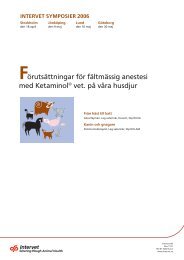KVÄLLSSYMPOSIUM 2008 Vaccinering av hund och katt
KVÄLLSSYMPOSIUM 2008 Vaccinering av hund och katt
KVÄLLSSYMPOSIUM 2008 Vaccinering av hund och katt
Create successful ePaper yourself
Turn your PDF publications into a flip-book with our unique Google optimized e-Paper software.
animal colonies were found to carry CAV-2<br />
in the respiratory tract [6,20]. By converse,<br />
CAV-2 was not detectable in dogs vaccinated<br />
in a rehoming center [61].<br />
The host range of CAV-2 includes<br />
a broad number of mammalian species.<br />
Wild-life animals may be a source of infection<br />
for domestic dogs. The overall<br />
prevalence of antibodies to canine adenoviruses<br />
in European red foxes (Vulpes<br />
vulpes) in Australia was 23.2% with<br />
marked geographical, seasonal and age differences<br />
[134], while the prevalence of antibodies<br />
was 97% in Island foxes (Urocyon<br />
littoralis) in the Channel Islands, California<br />
[70]. Antibodies to CAV-2 were also<br />
detected in free-ranging terrestrial carnivores<br />
and in marine mammals in Alaska<br />
and Canada, including black bears (Ursus<br />
americanus), fishers (Martes pennanti),<br />
polar bears (Ursus maritimus), wolves<br />
(Canis lupus), walruses (Odobenus rosmarus)<br />
and Steller sea lions (Eumetopias<br />
jubatus) [30, 120, 147].<br />
The route of infection of CAV-2 is oronasal.<br />
The virus replicates in non-ciliated<br />
bronchiolar epithelial cells, in surface cells<br />
of the nasal mucosa, pharynx, tonsillar<br />
crypts, mucous cells in the trachea and<br />
bronchi in peribronchial glands and type<br />
2 alveolar epithelial cells. In addition to<br />
these tissues, the virus can be isolated<br />
from retropharyngeal and bronchial lymph<br />
nodes as well as from the stomach and<br />
the intestine. The peak of replication is<br />
reached by 3–6 days post infection. Subsequently,<br />
virus loads rapidly decline, in<br />
relation to the production of antibodies,<br />
and CAV-2 usually can not be isolated by<br />
9 days post infection. Respiratory signs<br />
are consistent with damage of bronchial<br />
epithelial cells. There may be evidence<br />
of narcotising bronchitis or bronchiolitis<br />
and of bronchiolitis obliterans. Infection of<br />
type 2 alveolar cells is associated with interstitial<br />
pneumonia [5, 6, 9, 35, 47, 90].<br />
Dogs exposed to CAV-2 alone rarely<br />
show spontaneous disease signs, although<br />
Canine respiratory viruses 357<br />
lung lesions can be extensive. When additional<br />
bacterial or viral agents are involved,<br />
the ITB complex can be observed [5, 6].<br />
Antibodies to CAV-2 antigens h<strong>av</strong>e<br />
been demonstrated by hemagglutinationinhibition,<br />
agar gel diffusion, virus precipitation,<br />
complement fixation and by neutralization<br />
[90]. Protection appears to correlate<br />
with the neutralizing antibody levels [3,8].<br />
Nasal or throat swabs appear to be suitable<br />
for virus isolation. Primary dog kidney<br />
cells h<strong>av</strong>e been used successfully for<br />
isolation and cultivation of CAV-2 [55].<br />
However, a variety of cell lines are similarly<br />
susceptible to CAV-2 and to CAV-1<br />
[171]. Demonstration of CAV-2 antigen by<br />
immunofluorescence in acetone-fixed lung<br />
sections or tissue imprints is used for diagnosis<br />
of CAV-2. A polymerase chain<br />
reaction (PCR) assay has been developed<br />
to detect canine adenoviruses and to distinguish<br />
between CAV-1 and CAV-2 [82].<br />
Modified live CAV-2 vaccines proved<br />
to be highly effective in reducing the circulation<br />
of CAV-2 in canine populations.<br />
Dogs vaccinated with CAV-2 develop immunity<br />
to both CAV-1 and CAV-2 [3, 8].<br />
In a similar fashion, dogs vaccinated with<br />
CAV-1 develop immunity to both CAV-1<br />
and CAV-2 [43]. However, the use of<br />
CAV-2 for immunization of pups against<br />
both canine adenovirus types has eliminated<br />
safety side-effects encountered with<br />
CAV-1 vaccines, i.e. the occurrence of ocular<br />
lesions [24,48,90]. Maternally-derived<br />
antibodies in pups may prevent active immunization<br />
after vaccine administration up<br />
to the age of 12-16 weeks [8]. Vaccine<br />
administration by the intranasal route has<br />
been proposed to overcome the interference<br />
of maternal antibodies [8], but products<br />
for intranasal vaccination are not marketed.<br />
3. CANINE HERPESVIRUS<br />
Canine herpesvirus (CHV) is a memberoftheAlphaherpesvirinae<br />
subfamily





